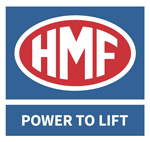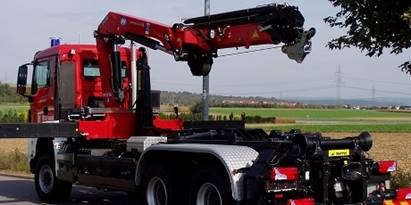Choosing the right truck-mounted crane for your needs is a complex exercise. However, there are a couple of key factors to consider. In this article, we explore the variables and characteristics of common truck-mounted loading cranes to help you to make an informed choice.
Crane Lifting Weights and Distances
Naturally, the basic job of a crane is to lift an object vertically, but the second question that influences what type of crane is best for your operation, is how far away the item to lift actually is. All cranes are rated by their “tonne/metre” rating, which is the tonnes to be lifted times the number of metres of reach required. For example, lifting 800kg with 15 metres of reach (from the centre of the crane, not the edge of the truck) requires 0.800 × 15 = 12 tonnes/meters.
Most cranes can be specified with a different number of hydraulic extensions, i.e., how far their jib extends. Therefore, ordering a crane that at least reaches the length of the tray is a good place to start.
Here’s a quick guide Ranked by Power to Weigh (Tonne/Meter divided by Tare Weight in tonnes) of some of Australia’s most popular truck mounted cranes:
| Ranking | Crane Brand | Model | Construction | Tonne/Meter | Lift kg/ Reach m | Power to Weight Ratio | Tare Weight | Radio Control | Stability System |
|---|---|---|---|---|---|---|---|---|---|
| 1st | HMF | 910K3 RCS EVS | High Tensile Steel | 7.1 | 780/9.1 | 7.47/1 | 950kg | Y | Dynamic |
| = 2nd | HMF | 1120K3 RCS EVS | High Tensile Steel | 8.9 | 930.9.6 | 6.47/1 | 1375kg | Y | Dynamic |
| = 2nd | Palfinger | PK 9.001 SLD 3 (non CE) | High Tensile Steel | 7.58 | 790/9.6 | 6.47/1 | 1170kg | Y | Pre-set |
| 4th | Palfinger | PK18502 SH | High Tensile Steel | 13.14 | 900/14.6 | 6.29/1 | 2090kg | Y | Pre-set |
| 5th | HMF | 1920K5 RCS EVS | High Tensile Steel | 13.4 | 900/14.9 | 6.22/1 | 2155kg | Y | Dynamic |
| 6th | Fassi | F85B.2-22 e-active | Cast-Iron/ Steel | 7.13 | 720/9.9 | 5.59/1 | 1275kg | Y | Pre-set |
| 7th | Hiab | X-HIPRO E-5 | Cast-Iron/ Steel | 13.2 | 880/15.0 | 4.71/1 | 2803kg | Y | Pre-set |
| 8th | Hiab | XS-088-3 HIDUO | Cast-Iron/ Steel | 7.5 | 780/9.6 | 4.57/1 | 1640kg | Y | Pre-set |
| 9th | Fassi | F195A 2 25 e-dynamic | Cast-Steel/ Steel | 12.07 | 810/14.9 | 4.06/1 | 2970kg | Y | Pre-set |
Truck Size for Mounted Cranes
The second question is: how big is the truck you need to fit the crane, and what is your payload requirement? To add to the complexity of this question, do you want the crane behind the cab or on the back of the tray? Placing it behind the cab keeps it out of the way and gives you more load flexibility. However, in Australia, the front axle load limit is a critical factor, meaning some heavy cranes may not be legal even on an empty truck if mounted behind the cab. A crane expert can answer these specific questions for you, but a lightweight and compact crane is a good place to start.
Radio Controlled or Manual Controls for Your Crane?

While a manually controlled crane is cheaper to purchase, unless you have a two-man crew in your truck, they also require a lot more walking around and take longer to load and unload. Radio-controlled cranes allow the operator to monitor and control the load from beside the load. Manual cranes require you to align the load, walk back to the controls, lower the load, and perhaps do this two or three times for every lift. Many building sites require a person alongside the load to monitor its lowering, requiring either radio control or a second man in the truck. Radio controls are also the safer option as directions can be given from a distance.
Truck-Mounted Crane Safety Systems
Every crane with more than 1 tonne on the load chart requires a rated capacity limiter system. In effect, this prevents the crane from being overloaded and running the risk of the truck being pulled over by the crane.
On all modern cranes, this is a digital system that recognises the amount of force on the crane and electronically de-rates the crane to keep it within safe working parameters. For example, a crane may be able to reach 15 metres and may be able to lift 3 tonnes safely at 5 metres, so the crane will prevent that load from being extended beyond its safe limit of (let’s say) 5.5 metres.
In most cases, these parameters are set by the crane dealer when fitting the crane to your new truck. These settings are different for every single truck/crane combination and are required by law to be set at a safe level when the crane is delivered. It is both illegal and extremely dangerous to disable these systems.
These safety systems also look at the position of the stabiliser legs and determine the safe program according to the position of the leg. To ensure these settings are safe, they are generally set based on the truck being empty. Having a load makes the truck more stable (because it is heavier), but most crane control systems cannot identify this increased stability.
The patented HMF EVS (electronic vehicle stability) system is unique in that it dynamically sets the crane’s performance parameters according to the stability of a truck for every situation. This means the crane automatically increases its reach and lift capacity to the maximum safe level of the truck with its load in any given situation. More load means more stability, which in turn means more reach. This is particularly important on medium and large cranes.
Crane Slewing Angle
The final piece of the puzzle to consider is the slewing angle. That is the amount of rotation the crane can make. A typical slew range is around 400–420 degrees, meaning the crane can rotate slightly more than a full circle.
Some large cranes are equipment with a system called “infinite slew”, meaning the crane is not limited by the amount of rotation. It can go around in a full circle without limit because it has very sophisticated rotary couplings and slew motors instead of a rack, which allows the crane to rotate without limit.
Other Things to Keep in Mind
Crane Electronics
Another question to consider is how many sensors there are on the crane. With cranes becoming ever more sophisticated, safety systems and electronic sensors have increased in use enormously. Some crane manufacturers have simply added sensors to an old design, while others have re-designed their cranes for new technology. Keeping the number of sensors to a minimum increases on-road reliability.
Crane Hydraulics
When considering the crane’s hydraulics, you may want to ask: how well protected are the hydraulic lines and sensors? Are they external or internal? The less exposed the hydraulics are, the less likely they are to snag on a load or kerbside object, reducing the risk of damage. HMF models also run their hydraulic hoses internally compared to other crane manufacturers, providing an added layer of protection.
Surface Finish
You’re about to spend a lot of money on a crane. Is it painted or powder-coated? Painted steel may require more maintenance in the long term compared to powder-coated steel, which is electrostatically covered in a layer of powder which is then cured or sealed with heat or UV light to form a protective layer to defend against corrosion, rust, and incidental damage from the environment. HMF also use EQC surface protection, meaning the surface treatment is environmentally friendly to the highest standards while still providing exceptional protection, even in coastal and industrial areas.
West-Trans: The Trusted Name in Lifting Equipment
There’s a lot to consider when choosing a truck-mounted loading crane, from the versatility of its boom, its manoeuvrability, and the overall cost and efficiency of the equipment at hand.
Call our friendly team at West-Trans Equipment today and talk to one of our experts about your industry’s operations and demands. With decades of experience, our experts can help you choose the right heavy-duty crane for your job or construction site. Get in touch with us today!



